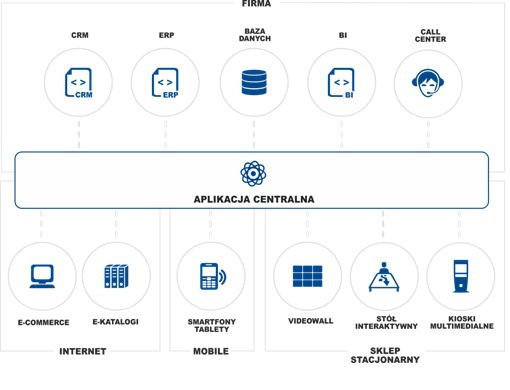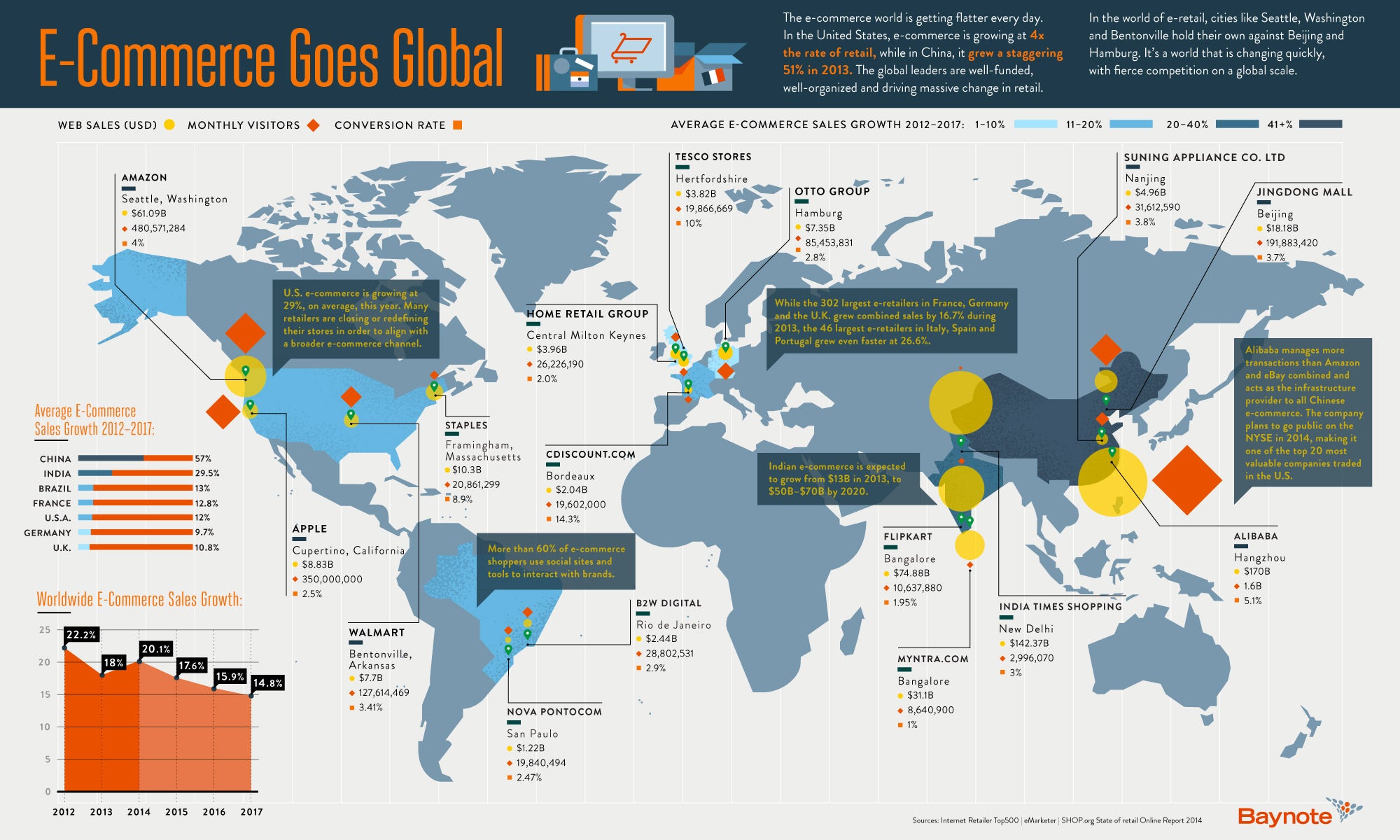Moda na wiele kanałów
Friday, 25th April 2014
Na portalu Ecommerceblog.pl pojawił się artykuł o wielu kanałach docierania do konsumenta.
"WspóÅ‚czesnego konsumenta, podążajÄ…cego za najnowszymi rynkowymi trendami, wcale nie trzeba uczyć, jak dotrzeć do informacji o interesujÄ…cych go produktach. Åšwiadomość szerokiego wachlarza możliwoÅ›ci kontaktu, niejako wymusza na sprzedawcy uruchamianie tych kanaÅ‚ów, z jakich chce korzystać klient."
"PodejÅ›cie do wielokanaÅ‚owoÅ›ci przeszÅ‚o dÅ‚ugÄ… drogÄ™ ewolucji w Å›wiadomoÅ›ci detalistów. W oczach przedsiÄ™biorcy salon stacjonarny, sklep internetowy, interaktywny kiosk czy aplikacja mobilna, nie sÄ… już traktowane jako caÅ‚kowicie odrÄ™bne kanaÅ‚y sprzedaży. Kluczem do sukcesu jest spójność wszystkich wykorzystywanych narzÄ™dzi i kanaÅ‚ów. BÅ‚Ä™dem natomiast traktowanie każdego z kanaÅ‚ów jako osobno dziaÅ‚ajÄ…cego bytu. Oczywistym jest, że każdy z nich rzÄ…dzi siÄ™ innymi prawami, ale kluczowa jest traktowanie ich jako jedność – wdrożenie wspólnej strategii sprzedażowej oraz marketingowej."
"Multichannel otwiera przed sprzedawcÄ… wiele możliwoÅ›ci na wyróżnienie, a także usprawnienie dziaÅ‚ania przedsiÄ™biorstwa. ZwÅ‚aszcza w przypadku dużych firm czy sieci handlowych, pojawia siÄ™ potrzeba integrowania poszczególnych kanaÅ‚ów oraz systemów ERP, CRM, baz danych wykorzystywanych w codziennej pracy. Im wiÄ™cej przybywa systemów, tym coraz wiÄ™kszego znaczenia nabiera, że systemy te powinny dziaÅ‚ać razem, a nawet być zarzÄ…dzane z poziomu jednej centralnej aplikacji. Takie rozwiÄ…zanie zapewnia pracÄ™ na jednej bazie klientów i zbieranie informacji z kilku miejsc jednoczeÅ›nie, o ich zachowaniach zakupowych oraz upodobaniach."
"Popularność strategii wielokanaÅ‚owych potwierdzajÄ… wyniki ostatnich badaÅ„, przeprowadzonych przez firmÄ™ doradczÄ… CBRE wÅ›ród 50. wiodÄ…cych detalistów na Å›wiecie. Dane opracowane na podstawie ankiet jednoznacznie wskazujÄ… na to, że miÄ™dzynarodowe sieci handlowe planujÄ… silny rozwój wielokanaÅ‚owy w 2014 roku i co wiÄ™cej, chcÄ… korzystać przy tym z zaawansowanych, nowych technologii. 80 proc. badanych wskazuje na to, że wielokanaÅ‚owe dziaÅ‚ania zwiÄ™kszÄ… ruch klientów w ich salonach. Z kolei aż 87 proc. twierdzi, że wielokanaÅ‚owość może wpÅ‚ynąć pozytywnie na wysokość ich caÅ‚kowitych dochodów. Natomiast 66% ankietowanych przyznaÅ‚o, że gÅ‚ównym celem ich strategii cyfrowej jest dążenie do wzrostu przychodów poprzez zwiÄ™kszenie liczby odwiedzin zarówno online, jak i offline."
ŹródÅ‚o Ecommerceblog.pl
Mix and match: the benefits of mixing fraud detection models
Thursday, 24th April 2014
Crossborder Ecommerce published the article about the benefits of mixing fraud detection models.
"Merchants looking at cross-border expansion, or those already trading overseas, need to think carefully about their choice of fraud detection model to support sales growth and manage risk in new markets. As with any other component of the fraud strategy, flexibility is important for establishing an effective solution."
"Broadly speaking, merchants tend to favour either a Pass/Fail strategy – where an order is instantly approved or rejected by an automated fraud screening engine – or a Manual Review approach – where suspicious transactions are held for a final decision to be made by an order verification team."

Source Crossborder-ecommerce.com
"The Pass/Fail approach can work very well for merchants experiencing low decline and chargeback rates and higher false positives. A Manual Review strategy, on the other hand, provides greater flexibility and potential to realise additional revenue, but increases demand on resources."
"A growing number of cross-border merchants are finding that a mix of fraud detection models can best meet their requirements. Here are two examples of a mixed model approach:
- Example 1:
A US retail merchant sells and ships fashion accessories in the US, Canada, Europe and China. The merchant has a domestic review team implementing a Manual Review fraud detection model for US and Canadian orders. Language barriers, limited verification tools and local market data, time zone differences and resource limitations all make this approach difficult and more costly for their overseas operations. As a result, the merchant operates a secondary Pass/Fail model for orders originating from Europe and China. This approach has enabled the merchant to successfully reduce the risk of fraud internationally while keeping the cost of manual reviews to a minimum.
- Example 2:
Another online merchant selling electronic products, including high cost items such as tablets, computers and cameras, has very few resources available to review orders manually. This merchant deploys a Pass/Fail model for all mid-to-low cost orders and a secondary Manual Review model for high value orders. This allows the merchant to review high risk but potentially profitable orders, while maximising mid-to-low value transactions."
"An inappropriate fraud detection model can be very damaging so it is important that each merchant selects the approach best suited to their individual business, and to their domestic and cross-border expansion plans. An experienced ecommerce risk analyst can help to provide guidance to merchants on how to implement an effective solution that manages risk exposure while meeting sales and customer service goals."
Where E-Commerce Is Booming. Hint: Think Outside the U.S. - Infographic
Wednesday, 23rd April 2014
"China and India are expected to see faster e-commerce sales growth over the next five years than any other country, according to this infographic compiled by Baynote, a firm that helps companies drive personalized shopping experiences across multiple e-commerce channels. That means bigger things for Alibaba -- the e-commerce behemoth of China that currently oversees more transactions than Amazon and eBay combined – and Flipkart, the e-commerce giant of India."
"Growth in e-commerce sales depends on a country’s prospering middle class, access to capital and the sophistication of the mobile to computer experience, Baynote's director of marketing Marti Tedesco said in a blog post."
"As e-commerce explodes, you are going to be left behind if you aren’t making your business ever more mobile friendly. The expansion of e-commerce "directly translates into goods and services bought such as smartphones and electronics," Tedesco says. "Savvy retailers have capitalized on this new wealth by investing in mobile sites and apps that make buying goods online simple and accessible for more people than ever before.”"
(Click to enlarge). Source Entrepreneur
More info here.
Cross-border online shopping brims with growth opportunities - report
Tuesday, 22nd April 2014
According to this, cross-border online shopping brims with growth opportunities.
"As a result of the online interconnectedness of the world, there are many opportunities for online merchants, payment processors and delivery companies, which grow apace with cross-border online shopping development, according to the "Global Cross-Border B2C E-Commerce 2014" issued by the secondary research organization yStats.com."
"By 2020, online retail cross-border exports in the US, the UK, Germany, the Nordic nations, the Netherlands and France, are expected to reach EUR 100 billion, the same source indicates. Within these top countries, the most significant cross-border B2C ecommerce trade flow is between the US and the UK. The top six countries in online retail imports are the US, the UK, Germany, Brazil, China and Australia, according to yStats."
"The US is touted as one of the largest markets worldwide for cross-border B2C ecommerce, when it comes to both exports and imports. The countries most purchased from by online buyers in the US are the UK and China."
"In the Latin American B2C ecommerce space, cross-border online shopping plays a significant role. In countries such as Colombia, Paraguay and Venezuela, where domestic B2C ecommerce is underdeveloped, the majority of online purchases are cross-border."
"In Brazil, the number of cross-border online shoppers is predicted to reach nearly 10 millions by 2018, with expenditure increasing annually by almost a half. In 2013, the number of online shoppers in Argentina buying from foreign websites doubled, however, the country's authorities imposed regulatory restrictions on cross-border trade in January 2014."
"Cross-border B2C ecommerce is flourishing in Europe, backed by initiatives of the lawmakers in creating a single online retail infrastructure and regulation. More than a quarter of online buyers in the EU have made purchases from other EU countries, with this share being higher in the Euro area. The UK was the most popular destination for cross-border online shopping among European online shoppers purchasing abroad in 2013, followed by Germany and France."
"The UK is among the biggest cross-border B2C ecommerce exporters globally, supported by the popularity of UK brands around the world and the wide use of the English language. On the side of imports, only a small double-digit share of online shoppers in the UK buy from online retailers in other European countries, while the US, China and Hong Kong are more popular destinations. In other Western European nations, cross-border online shopping from the UK, Germany and the US is popular in France, while also a quarter of online stores in France shipped internationally."
"At a Eastern European level, cross-border online shopping is a growing trend in Russia. The cross-border B2C ecommerce sales of goods to Russia are expected to more than double in 2013, while traffic to top international ecommerce websites by Russian users almost quadrupled. Over 10% of online shoppers in Poland purchased from foreign online shops. The value of international ecommerce transactions made in Turkey reached over EUR 1 billion in 2013, growing by a third year-on-year."
"In Asian-Pacific, Singapore had the highest estimated share of cross-border B2C ecommerce in 2013, followed by Malaysia. Consumers worldwide make cross-border purchases from Japan, while also close to a fifth of online shoppers in Japan buy products online abroad."
"Cross-border B2C ecommerce in the Middle East and North Africa is growing by a high double-digit percentage number annually, supported by various services that assist shoppers in cross-border services. The US accounted for a third of the cross-border B2C ecommerce made by online shoppers in the MENA region."
Australia: first Bitcoin ATM launched
Monday, 21st April 2014
According to this, Westfield Sydney Central Plaza has become the first local retail shopping centre to welcome a Bitcoin ATM.
"The ATM, developed by ABA Technology, enables customers to withdraw cash from their existing Bitcoin wallets but also lets them turn their real wallet into a virtual one. On first access, customers will have to provide appropriate identification and according to ABA representatives, there's a stringent verification process in place before Bitcoins can be traded. Afterwards, consumers need to provide their phone number, PIN and the palm of their hand to authenticate transactions."
"The ATM has encryption security in place and fully complies with international regulations concerning unlawful transactions."
| Page: 2 / 9 | ||||
| Previous Page | 1 2 3 4 5 6 7 8 9 | Next Page | ||
Archive
- Latest
- February, 2024 (1)
- November, 2023 (2)
- June, 2023 (1)
- January, 2023 (1)
- November, 2022 (1)
- August, 2022 (1)
- July, 2022 (1)
- May, 2022 (1)
- April, 2022 (1)
- March, 2022 (3)
- April, 2016 (1)
- February, 2016 (1)
- November, 2015 (2)
- September, 2015 (4)
- August, 2015 (4)
- July, 2015 (6)
- June, 2015 (8)
- May, 2015 (4)
- April, 2015 (1)
- March, 2015 (3)
- February, 2015 (1)
- December, 2014 (35)
- November, 2014 (33)
- October, 2014 (28)
- September, 2014 (20)
- August, 2014 (30)
- July, 2014 (46)
- June, 2014 (40)
- May, 2014 (50)
- April, 2014 (41)
- March, 2014 (23)
- February, 2014 (54)
- January, 2014 (37)
- May, 2013 (19)
- April, 2013 (8)

